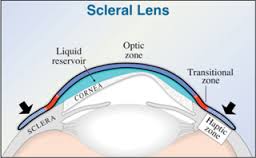“My last doctor said I could not wear contact lenses because of my prescription.”
While there are other reasons a patient may not be a good contact lens candidate, too much astigmatism or too high of a prescription is no longer one of them.
Scleral contact lenses were first introduced by a German glassblower in 1887, and now they are back and better than ever. These specialty contact lenses get their name from the way they fit on the eye. The sclera is the “white part of the eye”, and these lenses rest on the sclera and allow the lens to vault over the cornea. The cornea is the clear tissue in the front center portion of your eye. The cornea lies between the contact lens and the iris, which is the “colored part of the eye”. If the cornea has an abnormal shape, this causes astigmatism. Furthermore, a patient with corneal disease or a corneal scar will also have a high amount of astigmatism.
Soft contact lenses do not work for these patients because the soft lens will simply conform to the abnormal shape of the cornea. However, a scleral lens is made of a more firm material that maintains its own shape and does not conform to the irregular shape of the cornea. The scleral lens becomes the smooth “normal” shape the eye needs in order to properly focus light.
I know what you are thinking…”Scleral lenses are probably very uncomfortable?!” No, not at all! People that have tried “hard” contact lenses in the past may have reported discomfort; however the lenses they are referring to are small lenses that rest on the cornea alone. Every time one blinks the eyelids bump against the edges of those small corneal lenses. This causes one to think they have something in their eye. Sclera lenses are different.

The illustration to the left is a cross section of a scleral lens. Note the abnormal ‘cone’ shape of the cornea, which is characteristic of keratoconus. You can imagine the visual distortion caused by the cornea in the absence of a scleral contact lens.
Scleral lenses are larger, and once the patient gets them on the eye the edges are tucked underneath the eyelids. Therefore, scleral lenses are similar in comfort to soft contact lenses. If you have been told your prescription is too high or you have too much astigmatism to wear contacts, ask your eye doctor about scleral contact lenses.
Dr. Martin
Optometrist
Johnson Optometric Associates
Serving Fuquay-Varina and Garner, NC




